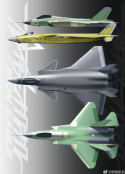I see where you are coming from -- though I think this discussion is more about medium term fleet procurement/orbat and opportunity costs, than the assessing the credibility of the rumours for the "land based J-XY/35".
From my view, I think a "mid-late maiden flight" for the land based J-XY/35, with a prospective entry into service around 2025-2026, IMO is very much not a rushed timetable, and if anything it is quite a relaxed one. This is for a few reasons:
- The land based J-XY/35 is coming out technically
after the standard carrier J-XY/35 has reached its first important milestones
- Both the land based J-XY/35 and standard carrier J-XY/35 are likely to share major subsystems (which will share the benefits in systems commonality like integration, testing, upgrades etc), if not share a degree of major commonality in eventual production as well.
- The land based J-XY/35 will likely be somewhat simpler to develop and test, than the standard carrier J-XY/35, given it will lack the extra engineering and testing needed for J-XY/35 to be carrier compatible.
All of which, is to say that in terms of prioritization, I think the standard carrier J-XY/35 will still be the highest priority, but the J-XY/35 will be a secondary project but will enjoy so much of the testing and experience from the standard carrier J-XY/35, that it can proceed with relatively low risk.
I also do not think that development and procurement of the "land based J-XY/35" (based on the above proposed timeline) necessarily comes at the cost of J-20 procurement.
Expansion of J-20 production capacity and expansion of the PLA's ability to absorb new J-20 production, imo, are not simply dependent on more money. The time needed to build up infrastructure (both larger production lines, as well as the PLA's support infrastructure for J-20s), and the long lead time for curating new aerospace engineers and production personnel and the subsystems line, IMO will place some limits on the pace of procurement of J-20 (or indeed, for any type of military hardware).
That isn't to say J-20 procurement is going to be "slow" -- I personally expect somewhere between 30-40 J-20s to be delivered this year, and going forwards to 2025 and the late 2020s, I wouldn't be surprised if they reach to 60ish J-20s annually as a program peak.
But it does mean that -- say, if they want to achieve 400-500 J-20s by 2025-2026, that probably isn't going to happen simply because I don't think they don't have the long lead infrastructure and personnel on the industry and PLA side to produce them and absorb them, respectively.
That means right now they should be spending money to expand J-20 production and absorption capacity (which I believe they are indeed doing) -- but they probably won't start seeing results from it until a couple of years down the line. That ends up with the question of what else can they spend money on to invest in the medium term future of air power 3-4 years down the line.
... Which takes us back to the question of whether a land based J-XY/35 makes sense for the PLAAF in terms of fleet procurement, in the post 2025 era, when considering the variety of programs the PLAAF will have going on by that period, and consideration of various rate limiting factors etc.
This question has been discussed a few times over the years (more J-20s vs land based J-XY/35, or clean sheet single engine 5th gen vs land based J-XY/35, or more J-20s vs clean sheet single engine 5th gen, etc), with my views articulated most clearly here:
And yes, what you described -- a "worse" J-20, with commonality with the navy, and a larger production run, more maintainable stealth, more advanced production method -- sounds like a hell of an aircraft to me, especially as such an aircraft would not need the additional development time needed...
www.sinodefenceforum.com
Overall, my position on it still remains the same, with the passage of a year.

